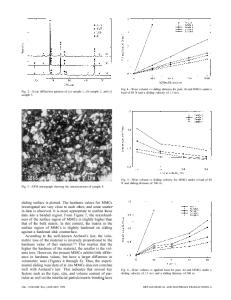Reactive synthesis of in-situ ZrAl 3 -Al 2 O 3 -Al composites
- PDF / 269,459 Bytes
- 4 Pages / 605.52 x 785.28 pts Page_size
- 102 Downloads / 366 Views
Reactive Synthesis of In-Situ ZrAl3-Al2O3-Al Composites W. DEQING, J. NEUMANN, and H.F. LÓPEZ In this work, a reactive synthesis process is proposed to obtain ZrAl3-Al2O3 particulate-reinforced aluminum matrix composites. The process involves the in-situ formation of Al2O3 and ZrAl3 from Al-ZrO2 green compacts. Upon compact heating, it is found that reduction of ZrO2 by molten aluminum occurs at temperatures above 750 ◦C, leading to the development of ZrAl3 and Al2O3 phases. Thermodynamically, it is found that the reduction of zirconium oxide is driven mainly by the dissolution of Zr in molten aluminum. Because the solubility of Zr in liquid aluminum is extremely small, the formation of ZrAl3 is favored after relatively small Zr dissolutions. The first Zr-Al intermetallics to form at the lowest temperatures seem to be metastable, as infered from the measured atom ratios for Al : Zr of 2.83 : 1. At increasing temperatures, the reaction comes into completion, resulting in the formation of equilibrium intermetallic ZrAl3 phases. The results obtained from differential scanning calorimetry (DSC) indicate that by increasing the scanning rates, both the reaction temperature and the exothermic peak intensity also increase. Alternatively, it is found that by reducing the amount of ZrO2 in the green compact, the in-situ reaction temperatures also shift toward higher values.
I. INTRODUCTION
COMPOSITE materials belong to a unique class of materials as their mechanical properties can be tailored to meet specific applications. Among the available composite materials, particulate-reinforced aluminum matrix composites have become increasingly attractive due to their unique mechanical and wear properties. Thus far, the most widely investigated aluminum-reinforced systems are the ones where Al2O3 or SiC are employed as particulate reinforcements.[1–5] Yet, there is a large number of noninvestigated particulate-reinforced aluminum systems with a high potential to replace conventional materials in numerous applications. In addition, there are various relatively new techniques currently available to produce in-situ metal matrix composites, which eliminate any imposed limitations in powder handling or reinforcement contamination. It is well known that oxidation or impurity contamination of the interfacial reinforcement surfaces often leads to poor matrixreinforcement bonding.[6] This limitation can be eliminated by employing relatively new processing methods. Among these methods, reaction synthesis has been employed in processing aluminum matrix composites, where the reinforcement phase is produced through an in-situ chemical reaction within the melt. As a result, thermodynamically stable particulate composites possessing clean interfaces[6] are produced. Several aluminum-X systems have been investigated using reaction synthesis techniques, where X is an oxide such as CuO,[7,8] ZnO, SnO, Cr2O3,[9] TiO2,[10–14] Nb2O5,[15] or Nd2O3.[16] Yet, there is still a large number of systems that need to be explored. Accordingly, the Al-ZrO2, whi
Data Loading...











